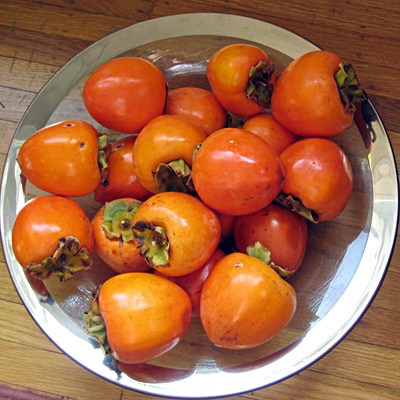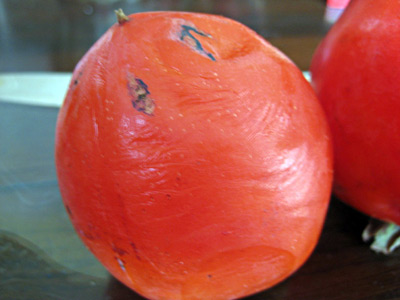
About a month ago, I wrote about Fuyu persimmons, which are one of my favorite fall fruits. This week, I'd like to extol the virtues of the Hachiya persimmon. Hachiyas are the misunderstood fruit of winter: although they are sweet and wonderful when baked into cakes and puddings, many people are afraid to eat them because they are truly awful when immature. A firm Hachiya is extraordinarily astringent and inedible. I admit that taking a bite out of one is sort of like eating an unripe bitter walnut while suddenly having all the moisture sucked out of your cheeks and tongue. But there's a very simple way to avoid this: don't eat Hachiyas until they're ripe.
Like Fuyus, Hachiyas range in color from light orange to a reddish sunset. They are easy to distinguish from Fuyus, however, because while the Fuyu looks like an orange tomato, the Hachiya is shaped like a large acorn. Hachiyas are lovely in both appearance and taste, just not at the same time. While they are outwardly attractive when unripe, they only become gastronomically appealing once the skin mottles and starts to shrivel over the soft ripened fruit. Yet while Hachiyas may not be pretty when they’re ready to be eaten, they are luscious when added to cakes and steamed puddings.

Before you eat a Hachiya, make sure it is soft and squishy as you need to wait for the fruit’s tannins to break down before the pulp loses its astringency and takes on a sweet and sugary flavor. The mature fruit has a jellylike texture, which may make them seem unappealing as a raw snack, but shouldn’t stop you from cooking with them. To coax Hachiyas into ripening, just set them out on your counter or window sill for a few days to over a week, depending on how firm they are. If you’re in a hurry, you can freeze a partially ripe Hachiya for at least 24 hours and then defrost it, which helps soften and sweeten the fruit. I tried this once and it worked okay, although the taste wasn’t as sweet as a naturally-ripened persimmon.